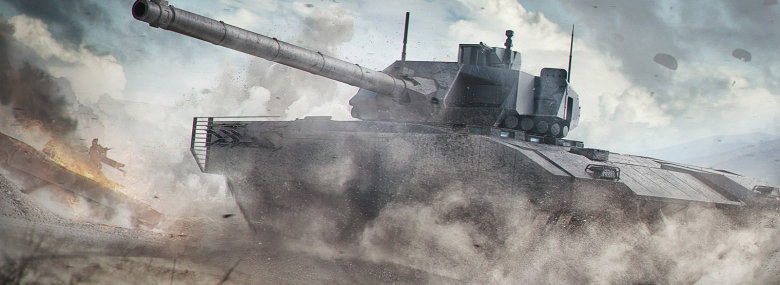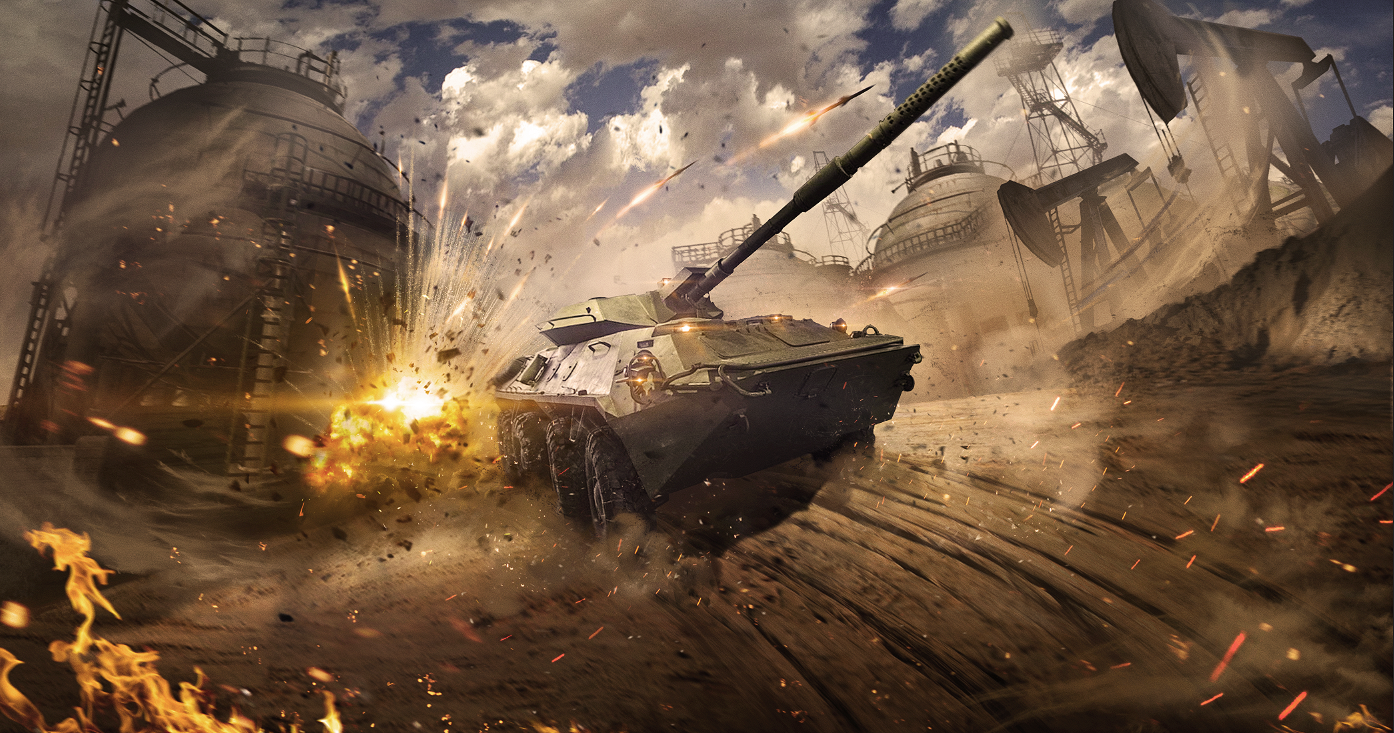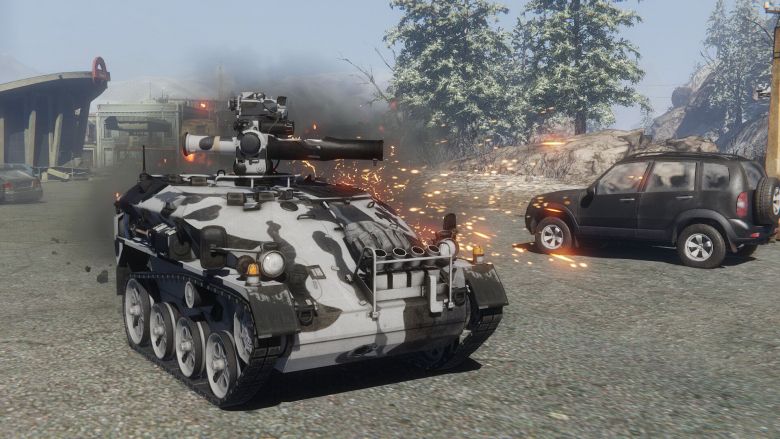
The history of the real life Tank Destroyer vehicles is quite complex and it would probably take a whole book to describe it – in fact, many books do just that. The intricacies and various details of the tank destroyer doctrine would cover many page – we’ll have to do with a shorter summary.
The Tank Destroyers (albeit many were not called as such) are vehicles specifically designed to kill enemy tanks on a budget. Whether designed from scratch or converted from another existing vehicle, their battlefield role remained the same for a long time – to engage the enemy at long distances (ideally so long that the enemy cannot retaliate) and to retreat (or advance) afterwards to repeat the process.

The Tank Destroyer class saw its golden days during the Second World War, where various dedicated or improvised vehicles were devised to fight the seemingly unbeatable hordes of German Panzers (and – vice versa – the unstoppable Red Army tide in the second half of the war). Americans in particular created a whole military branch and doctrine dedicated to this goal, while possibly the most effective German vehicle of the war, the StuG III, was in fact a self-propelled gun as well as a capable tank killer in some of its iterations.
Many of these wartime vehicles used existing chassis (for example the Panzer II or the Panzer 38 (t) for the German Marder series, the Panzer III chassis for the StuG III series or the T-34 chassis for the Soviet SU-85 and the SU-100) fitted with a more powerful gun than such a vehicle would normally be able to carry – there was a price though: the gun was almost always fixed and could only aim forward in a certain limited angle (called gun traverse angle). Such a vehicle would then wait hidden in ambush to surprise the enemy, fire and then bail out because its thin armor could not sufficiently protect it.
There were exceptions to this of course. The American Tank Destroyers such as the M36 were turreted and, to a degree, behaved like actual tanks. They were often faster but less protected with the top of the turret open. The extreme case of this would be the M18 Hellcat, one of the fastest tracked vehicles of the Second World War. Its extreme speed did it, however, little good as it was often slowed down by the terrain or the other vehicles it was bound to escort.
The Germans, on the other hand, built several superheavy Tank Destroyers such as the Elefent and the dreaded Jagdtiger. These were heavily armored but slow and ponderous monsters, whose reputation in combat was vastly overblown by both propaganda and soldier stories of fighting them (and defeating them, of course – some written “partisan” accounts contain more Elefants destroyed than were actually built in total). These vehicles were also extremely expensive and relatively fragile. While their guns were deadly, the limited experience of their crews and logistics issues made them simply not worth it (this sub-class disappeared with the end of the war). On the other hand, the Soviet SU-152 and ISU-152 series were quite successful thanks to their ability to act as artillery and remained in service in such role for a very long time (some of them were for example still used by the Iraqi during the Gulf War).
After the war, the Tank Destroyer class was rapidly replaced by a universal combat vehicle – the Main Battle Tank. Few post-war gun Tank Destroyer designs achieved any significance – the best-known example would be the German Kanonenjagdpanzer, designed to utilize the obsolete 90mm guns the Germans were left with after the older Patton models were pushed out of service. Since then, most of such vehicle proposals (for example to build such a vehicle on Leopard 1 chassis or even a Leopard 2-based one) remained in experimental stage and the Taifun II prototype was, more or less, the last hurrah of this class. On the Russian side, perhaps the most powerful such vehicle and one of the last ones of its kind was the SU-152 Taran prototype of 1965.
The need to kill enemy tanks effectively did not, however, disappear.

In the 1960s, the classic gun-armed Tank Destroyers started disappearing as a class, but many designs vied to take their place. These can be split into three categories:
- ATGM-based tank killers
- Fire Support Vehicles
- Improvised or Homegrown Tank Destroyers
The first category includes special vehicles armed mostly with anti-tank guided missiles, sometimes with additional machineguns. It often overlaps with Armored Fighting Vehicles that usually use the same chassis. Typical examples would include the German Raketenjagdpanzer, the British FV438 Swingfire or the Russian Kornet missile launcher on Tigr-M chassis. The massive downside of these vehicles is that while they are often excellent at killing enemy tanks, they are useless for everything else as knocking down a wall with an expensive guided missile is a massive waste. As such, their role on the battlefield is limited.
The second category includes vehicles such as the M1128 Stryker that are capable of killing enemy tanks (especially older ones) with their MBT-class guns, but are primarily intended to provide fire support to friendly infantry and lighter-armed vehicles. These are very universal but generally poorly armored and cannot go toe to toe with enemy MBTs. Russian vehicles such as the Sprut-SD also fall into this category with the Zhalo-S being an exception – unlike others, it was actually designed as a Tank Destroyer, but its gun proved to be too weak to serve as such and the project was shelved.
The third category includes various vehicles developed in countries that either cannot afford to buy a fleet of modern Main Battle Tanks or are under some sort of embargo. This category is fairly rare and almost never exported – these vehicles are built not out of desire, but out of necessity and are quickly replaced whenever the opportunity arises. Examples could include the Chinese Tank Destroyers from the 1980s or earlier and various Cuban or North Korean contraptions of limited combat value.
It’s worth noting that even the abovementioned “modern” Tank Destroyers are almost never called so and the category name is thus slowly passing into obscurity. During the recent years, we are, however, seeing a rise of a hybrid class of vehicles, capable of both supporting infantry and killing tanks. These are the Russian BMPT-series and although the Russians were definitely not the only ones attempting to develop such a vehicle, the Terminators, as they are called, are by far the best known.
Classification
In Armored Warfare, the Tank Destroyer class covers most of the abovementioned vehicles, although, in some cases, it heavily overlaps with the Light Tank class or the Armored Fighting Vehicle class. The easiest classification is to divide them into
- Missile Tank Destroyers
- Gun Tank Destroyers
Missile Tank Destroyers are – as the name suggests – armed with guided missiles. Examples include:
- Wiesel TOW
- Wiesel HOT
- Swingfire
- M1134
- Terminator series
- T-15 HIFV
The missile tank destroyers come in two flavors – light and heavy. The light ones are both tracked (Wiesel, Swingfire) and wheeled (M1134). They are generally very fast (although not as fast or agile as the Armored Fighting Vehicles) and stealthy but have very poor armor and, most importantly, no gun weaponry.
That means that they have to stay away from the enemy for as long as possible. They are defenseless at close range and are the natural prey of the AFV and LT classes. Their gameplay is somewhat similar to the light AFVs – they have to stay hidden behind cover. But unlike the AFVs that spot the enemy, the TDs are actually supposed to fire at them. They need to remain stationary during the missile flight as missiles are almost impossible to control in motion. If you like the patient, stationary style of a true sniper combined with difficult but incredibly rewarding hits, these vehicles are just for you.

The heavy missile tank destroyers are a different beast entirely. They consist of the Terminator series and the T-15 HIFV. Earlier, these vehicles were listed as AFVs but were changed to the Tank Destroyer class to better reflect their in-game role. These vehicles consist of heavily armored (MBT-level) hulls and lightly armored unmanned or low-profile turrets. They can fire multiple missiles in a row (most often four), can deal tremendous damage in a few seconds and are armed with autocannons as their backup weapon. On the downside, they are massive and very conspicuous, resulting in poor camouflage factor values. While their hulls can take tremendous punishment, their turrets are generally only lightly armored and easy hits can be scored them due to their size. Finally, they are roughly as mobile as Main Battle Tanks, resulting in few chances to run away. These vehicles can be played as mid-range support, staying behind the MBT picket line and shelling the enemy with their guided missile fire before retreating to reload. Should a pesky AFV get behind your line, these vehicles will make short work of it with their autocannons. If you prefer the Tank Destroyer class but like to have more options, these are the vehicles for you, but they are only available on high Tiers (Tier 8 and above).
Gun Tank Destroyers are, surprisingly, armed with guns. Examples include:
- LAV-300 and LAV-600
- ERC-90 F4
- Centauro series, including the B1 DRACO
- M1128 Stryker
- Wilk XC8
- Zhalo-S
- Taifun II
The gun tank destroyers are predominantly wheeled vehicles with only the Taifun II being an exception. The Taifun II is in fact exceptional in several ways – it’s the only casemate Tank Destroyer with fixed gun currently in game, making its gameplay difficult but rewarding.

Generally speaking, where the missile tank destroyers are stationary snipers, the wheeled tank destroyers are mobile snipers. They are all fast (although not as much as the AFVs or the LTs) and maneuverable, allowing them to drive from cover to cover, shell the enemy at long distances thanks to their exceptional stationary firepower and then disappear again. If you like this mobile sniper gamestyle, this class is for you, but beware: their stealth and accuracy are balanced by their fragility that becomes more accentuated on higher Tiers, making this sub-class suitable for advanced players. They are also not very accurate when moving and cannot act like Light Tanks. Attempting to do so would lead to your quick demise.
Tank Destroyer Battlefield Role
As was stated above, with several exceptions, the role of these vehicles on the battlefield is long-range sniping. The static accuracy of the class is unparalleled, but it suffers when the vehicle is moving and the Tank Destroyer vehicles cannot be used effectively for firing on the move – at least not as well as other classes.
The key is to stay hidden behind some cover, ideally a bush or two, that increase your camouflage factor. Some of the lightest vehicles can stay hidden effectively even after firing their gun or a missile, others have to immediately retreat or seek different cover (especially on higher Tiers where more advanced anti-stealth such as thermal optics are available).
Waiting along the expected routes of enemy approach is a good idea and all maps contain a number of spots that allow just that. In ideal case, a skilled Tank Destroyer player not only locates a suitable position for sniping, but also plans his escape route and the way to the next firing position or two. Like the Armored Fighting Vehicles, the Tank Destroyers require knowledge of each map for high-quality gameplay as a Tank Destroyer driver who does not remember where suitable spots are can find himself with few options left. Of all the classes in Armored Warfare, the Tank Destroyers require perhaps the most patience and planning.






